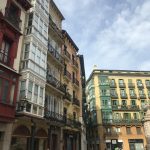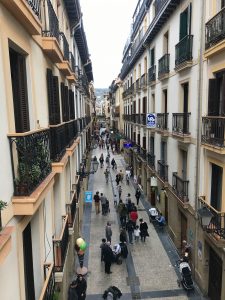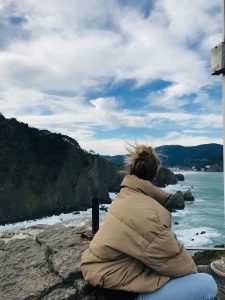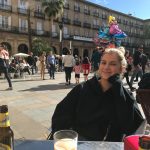 Este mes, fui a San Sebastián y Bilbao, dos ciudades en el País Vasco. Como no he viajado muchos lugares en el norte, y me intrigó ver los contrastes entre el norte y el sud de España, especialmente en el país vasco, que es una región autónoma que se enorgullece de su cultura distinta. En España, una comunidad autónoma es una división política y administrativa del primer nivel, creado de acuerdo con la constitución española de 1978, con el objetivo de garantizar una autonomía limitado de las nacionalidades y regiones que componen España. Por lo tanto, las comunidades autónomas se rigen según la constitución de España y sus propias leyes orgánicas conocidas como Estatutos de Autonomía.
Este mes, fui a San Sebastián y Bilbao, dos ciudades en el País Vasco. Como no he viajado muchos lugares en el norte, y me intrigó ver los contrastes entre el norte y el sud de España, especialmente en el país vasco, que es una región autónoma que se enorgullece de su cultura distinta. En España, una comunidad autónoma es una división política y administrativa del primer nivel, creado de acuerdo con la constitución española de 1978, con el objetivo de garantizar una autonomía limitado de las nacionalidades y regiones que componen España. Por lo tanto, las comunidades autónomas se rigen según la constitución de España y sus propias leyes orgánicas conocidas como Estatutos de Autonomía.
 El País Vasco está formado por siete provincias que se extienden por partes del norte de España y el sur de Francia con su propio pueblo (El pueblo vasco: Euskaldunak), idioma (vasco: Euskara) y cultura y tradiciones.
El País Vasco está formado por siete provincias que se extienden por partes del norte de España y el sur de Francia con su propio pueblo (El pueblo vasco: Euskaldunak), idioma (vasco: Euskara) y cultura y tradiciones.
La primera diferencia que se nota cuando entre la región es la idioma: los las señales de tráfico, los menús, los carteles de las tiendas y los anuncios están todos en euskera, sólo que a veces con el castellano debajo. El paisaje verde y montañoso también cambia de gran parte del resto de la campiña española, que a menudo es seca y plana.
Por casi cuarenta años sufrieron abajo del régimen impuesto por la dictadora Francisco Franco, que prohibió el uso de la lengua y las expresiones culturales. Los aldeanos a través de los territorios vascos fueron penalizados o encarcelados si se les veía hablando o mostrando sus tradiciones. Cuando el castellano se hizo cargo, el euskera perdió su atractivo y el número de hablantes disminuyó drásticamente durante más de dos generaciones. Resistentemente, después de que la dictadura en España terminara, se hicieron esfuerzos para resucitar la lengua y la cultura, para asegurar que continuara durante los años venideros.
 Hoy en día, el euskara está prosperando gracias a los esfuerzos realizados por los movimientos de base en los años 60 y a los planes de revitalización del gobierno vasco establecidos tras la transición a la democracia en España a finales de los 70. Nuestro guía turístico en Bilbao nos dijo que ahora los niños tienen la opción de estudiar en euskera o en castellano, con el 52% eligiendo el euskera y el 48% eligiendo el castellano, con la lógica de que si estudias en euskera, tienes garantizado el dominio de ambos idiomas, pero sería poco probable que llegaras a dominar el euskera si no lo aprendes desde una edad temprana, debido a su naturaleza única y a la diferencia con cualquier otro idioma.
Hoy en día, el euskara está prosperando gracias a los esfuerzos realizados por los movimientos de base en los años 60 y a los planes de revitalización del gobierno vasco establecidos tras la transición a la democracia en España a finales de los 70. Nuestro guía turístico en Bilbao nos dijo que ahora los niños tienen la opción de estudiar en euskera o en castellano, con el 52% eligiendo el euskera y el 48% eligiendo el castellano, con la lógica de que si estudias en euskera, tienes garantizado el dominio de ambos idiomas, pero sería poco probable que llegaras a dominar el euskera si no lo aprendes desde una edad temprana, debido a su naturaleza única y a la diferencia con cualquier otro idioma.
Habiendo visitado ahora, puedo ver por qué están orgullosos de su región y su idioma, y quieren preservarlo. Es una parte hermosa e histórica del país, en la que se ha invertido mucho y se ha cuidado bien. Está claro que quieren aferrarse a sus costumbres centenarias, ya que saben lo que es que se las quiten.
 This month, I took a trip north to 2 cities in the Basque country: San Sebastián and Bilbao. Having not travelled to many places in the north of Spain, I was intrigued to see the contrasts between the north and south of Spain, especially in the Basque country, which is an autonomous region which prides itself on its distinct culture. In spain, an autonomous community is a first-level political and administrative division, created in accordance with the Spanish constitution of 1978, with the aim of guaranteeing limited autonomy of the nationalities and regions that make up Spain. Therefore, the autonomous communities are governed according to the constitution of Spain and their own organic laws known as Statutes of Autonomy.
This month, I took a trip north to 2 cities in the Basque country: San Sebastián and Bilbao. Having not travelled to many places in the north of Spain, I was intrigued to see the contrasts between the north and south of Spain, especially in the Basque country, which is an autonomous region which prides itself on its distinct culture. In spain, an autonomous community is a first-level political and administrative division, created in accordance with the Spanish constitution of 1978, with the aim of guaranteeing limited autonomy of the nationalities and regions that make up Spain. Therefore, the autonomous communities are governed according to the constitution of Spain and their own organic laws known as Statutes of Autonomy.
The Basque country is made up of seven provinces spanning across parts of northern Spain and southern France with its own people (The Basque People: Euskaldunak), language (Basque: Euskara) and culture and traditions.

The first difference you notice when entering the region is the language, the road signs, menus, shop signs and adverts are all in Basque, only sometimes with Castellano underneath. The green hilly countryside also makes a change from much of the rest of Spain’s countryside which is often dry and flat.
For almost 40 years they suffered under the regime imposed by Dictator Francisco Franco which prohibited the use of the Basque language and cultural expressions. Villagers throughout the Basque territories were penalized and even jailed if they were seen speaking or showcasing their traditions. When the Spanish language took over, the Basque language lost its appeal and the number of speakers dramatically decreased for over two generations. Resiliently, after the dictatorship in Spain ended efforts were made to resurrect the language and culture, to ensure it continued for years to come.
 Nowadays, Euskara, is thriving thanks to the efforts made by grassroots movements in the 1960’s and the Basque government revitalization plans established after the transition to democracy in Spain in the late 70’s. Our tour guide in Bilbao told us that now children have the choice to study in Basque or Castellano, with 52% choosing Basque and 48% choosing Castellano, with the logic that if you study in Basque, you are guaranteed to be fluent in both languages, but it would be unlikely you’d become fluent in Basque if you weren’t to learn it from a young age, due to its unique nature and dissimilarity to any other languages.
Nowadays, Euskara, is thriving thanks to the efforts made by grassroots movements in the 1960’s and the Basque government revitalization plans established after the transition to democracy in Spain in the late 70’s. Our tour guide in Bilbao told us that now children have the choice to study in Basque or Castellano, with 52% choosing Basque and 48% choosing Castellano, with the logic that if you study in Basque, you are guaranteed to be fluent in both languages, but it would be unlikely you’d become fluent in Basque if you weren’t to learn it from a young age, due to its unique nature and dissimilarity to any other languages.
Having now visited, I can see why they are proud of their region and language, and want to preserve it. It is a beautiful and historic part of the country, which has been highly invested in, and looked after well. It’s clear they want to hold onto their century old customs, as they know what it is like to have them taken away.
